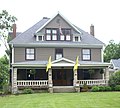Gallery
- Historic 1818 home of Felix and Odile Vallé and trading firm of Menard and Vallé.
- Historic 1806 home of Jacques Jean Rene Guibourd.
- The Amoureux House.
- Maison Bequette-Ribault after restoration.
- The Bolduc House.
- The John N. and Elizabeth Taylor House in Columbia, Missouri.
- The Maplewood House in Columbia, Missouri.
- The Sanford F Conley House on the campus of the University of Missouri - Columbia







